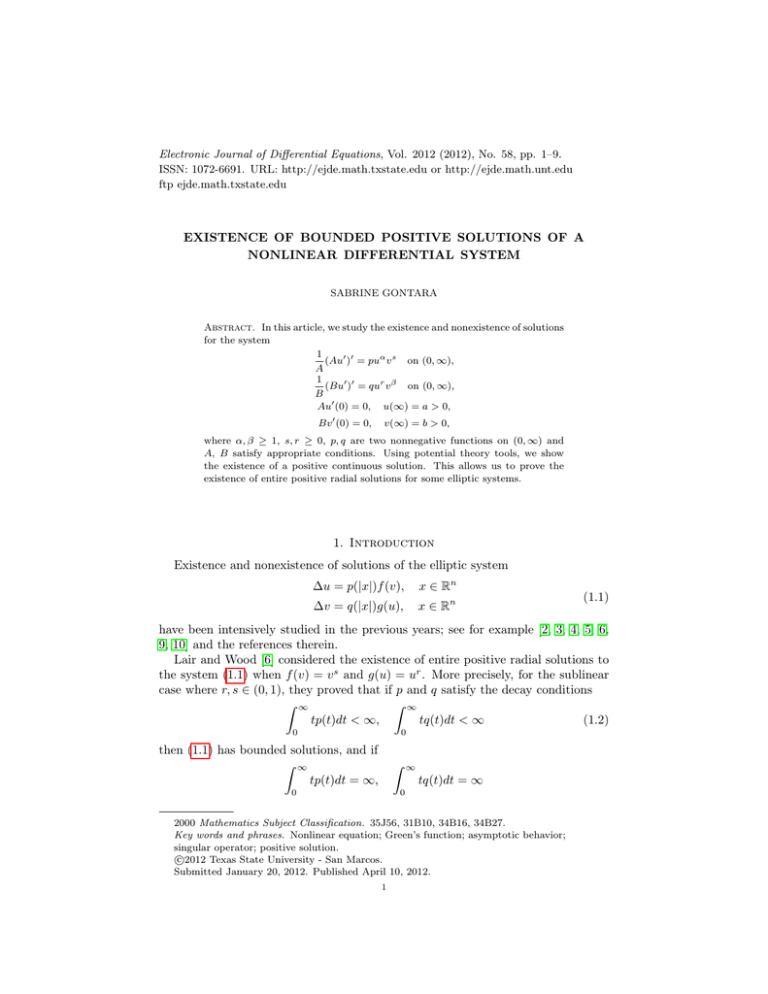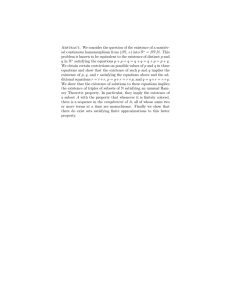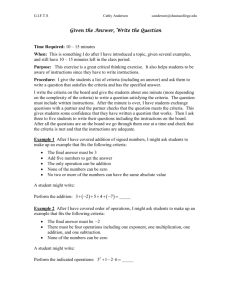Electronic Journal of Differential Equations, Vol. 2012 (2012), No. 58,... ISSN: 1072-6691. URL: or
advertisement

Electronic Journal of Differential Equations, Vol. 2012 (2012), No. 58, pp. 1–9.
ISSN: 1072-6691. URL: http://ejde.math.txstate.edu or http://ejde.math.unt.edu
ftp ejde.math.txstate.edu
EXISTENCE OF BOUNDED POSITIVE SOLUTIONS OF A
NONLINEAR DIFFERENTIAL SYSTEM
SABRINE GONTARA
Abstract. In this article, we study the existence and nonexistence of solutions
for the system
1
(Au0 )0 = puα v s on (0, ∞),
A
1
(Bu0 )0 = qur v β on (0, ∞),
B
Au0 (0) = 0, u(∞) = a > 0,
Bv 0 (0) = 0,
v(∞) = b > 0,
where α, β ≥ 1, s, r ≥ 0, p, q are two nonnegative functions on (0, ∞) and
A, B satisfy appropriate conditions. Using potential theory tools, we show
the existence of a positive continuous solution. This allows us to prove the
existence of entire positive radial solutions for some elliptic systems.
1. Introduction
Existence and nonexistence of solutions of the elliptic system
∆u = p(|x|)f (v),
x ∈ Rn
∆v = q(|x|)g(u),
x ∈ Rn
(1.1)
have been intensively studied in the previous years; see for example [2, 3, 4, 5, 6,
9, 10] and the references therein.
Lair and Wood [6] considered the existence of entire positive radial solutions to
the system (1.1) when f (v) = v s and g(u) = ur . More precisely, for the sublinear
case where r, s ∈ (0, 1), they proved that if p and q satisfy the decay conditions
Z ∞
Z ∞
tp(t)dt < ∞,
tq(t)dt < ∞
(1.2)
0
0
then (1.1) has bounded solutions, and if
Z ∞
tp(t)dt = ∞,
Z
∞
tq(t)dt = ∞
0
0
2000 Mathematics Subject Classification. 35J56, 31B10, 34B16, 34B27.
Key words and phrases. Nonlinear equation; Green’s function; asymptotic behavior;
singular operator; positive solution.
c
2012
Texas State University - San Marcos.
Submitted January 20, 2012. Published April 10, 2012.
1
2
S. GONTARA
EJDE-2012/58
then (1.1) has large solutions. For the superlinear case, where r, s ∈ (1, ∞), the
authors proved the existence of an entire large positive solution of (1.1), provided
that p and q satisfy (1.2).
Later, their results were extended by Cı̂rstea and Radulescu [2] which considered
(1.1) under the following conditions on f and g:
f (cg(t))
= 0, for all c > 0.
t
To study (1.1), Ghanmi et al in [4] considered the system
1
(Au0 )0 = p(t)g(v) t ∈ (0, ∞),
A
1
(Bv 0 )0 = q(t)f (u) t ∈ (0, ∞),
B
u(0) = α > 0, v(0) = β > 0,
lim
t→∞
Au0 (0) = 0,
Bv 0 (0) = 0,
where A, B are continuous functions on (0, ∞), and p, q, f and g are nonnegative
and continuous functions on [0, ∞). They proved that if f and g are lipschitz
continuous functions on each interval [, ∞), > 0, system (1.1) has a unique
bounded positive solution (u, v) satisfying u, v ∈ C([0, ∞)) ∩ C 1 ((0, ∞)).
In this article, we are interested in the study of positive radial solutions to the
semilinear elliptic system
∆u = p(|x|)uα v s ,
x ∈ Rn
∆v = q(|x|)ur v β ,
x ∈ Rn
(1.3)
where α, β ≥ 1, r, s ≥ 0 and p, q : (0, ∞) → [0, ∞) satisfying (1.2). To this end, we
undertake a study of the system of semilinear differential equations
1
(Au0 )0 = puα v s on (0, ∞),
A
1
(Bv 0 )0 = qur v β on (0, ∞),
(1.4)
B
Au0 (0) = 0, u(∞) = a,
Bv 0 (0) = 0,
v(∞) = b,
where a, b > 0 and the functions A and B satisfy condition (H0) below. In this
paper, we denote u(∞) := limx→∞ u(x) and Au0 (0) := limx→0 A(x)u0 (x).
To simplify our statement, we denote by B + ((0, ∞)) the set of nonnegative
measurable functions on (0, ∞). Also we refer to C([0, ∞]) the collection of all
continuous functions u in [0, ∞) such that limx→∞ u(x) exists and C0 ([0, ∞)) the
subclass of C([0, ∞]) consisting of functions which vanish continuously at ∞.
Before presenting our main result, we would like to make some assumptions and
recall some properties of the operator Lu = A1 (Au0 )0 , while referring the reader to
[7, 8] for furthers details. Throughout this paper, we say that a function A satisfies
condition (H0) if
(H0) A is a continuous function on [0, ∞), differentiable and positive on (0, ∞)
such that
Z ∞
Z 1
Z
dt
1 t
< ∞ and
A(s)ds dt < ∞.
A(t)
1
0 A(t)
0
EJDE-2012/58
EXISTENCE OF BOUNDED POSITIVE SOLUTIONS
3
For a function A satisfying (H0), we denote by G the Green’s function of the
operator Lu = A1 (Au0 )0 on (0, ∞) with Dirichlet conditions Au0 (0) = 0, u(∞) = 0;
that is,
Z ∞
dr
G(x, t) = A(t)
, for (x, t) ∈ ((0, ∞))2 ,
A(r)
x∨t
where x ∨ t := max(x, t) and we refer to the potential of a function f in B + ((0, ∞))
by
Z
∞
V f (x) =
G(x, t)f (t)dt.
0
We point out that for each f ∈ B + ((0, ∞)) such that V f (0) < ∞, the function
V f ∈ C0 ([0, ∞)) ∩ C 1 ((0, ∞)) and satisfies
L(V f ) = −f
a.e. on (0, ∞),
0
A(V f ) (0) = 0,
V f (∞) = 0.
Let us introduce the conditions imposed to the functions p and q:
(H1) p, q : (0, ∞) → [0, ∞) are two measurable functions such that
V p(0) < ∞
and W q(0) < ∞.
Here for f ∈ B + ((0, ∞)), we denote
Z
∞
H(x, t)f (t)dt,
W f (x) =
0
where
Z
∞
dr
.
B(r)
x∨t
Using a fixed point argument, we prove our main result.
H(x, t) = B(t)
Theorem 1.1. Let A and B be two functions satisfying (H0) and let p, q be two
functions satisfying (H1). Then for each a, b > 0, system (1.4) has a positive solution (u, v) satisfying u, v ∈ C([0, ∞]) ∩ C 1 ((0, ∞)). Moreover, there exist c1 , c2 > 0
such that for each x ∈ [0, ∞), we have
a exp(−c1 V p(0)) ≤ u(x) ≤ a,
b exp(−c2 W q(0)) ≤ v(x) ≤ b.
Remark 1.2. If A(t) = B(t) = tn−1 , the condition (H1) is equivalent to (1.2).
It follows by Theorem 1.1 that if p, q satisfy (1.2) then for each a, b > 0, the
elliptic system (1.3) has a positive radial solution (u, v) continuous in Rn such that
lim|x|→∞ u(x) = a and lim|x|→∞ v(x) = b.
The outline of this article is as follows. In Section 2, we lay out some properties
pertaining with potential theory and we give some useful results related to the
operator Lu = A1 (Au0 )0 . In particular, we establish an existence and a uniqueness
result to the problem
Lu = p(x)uα , x ∈ (0, ∞)
(1.5)
Au0 (0) = 0, u(∞) = a > 0,
where α ≥ 1 and p ∈ B + ((0, ∞)) such that V p(0) < ∞. This allows us to prove
Theorem 1.1 in Section 3 by using a technical method that requires a potential
theory approach.
4
S. GONTARA
EJDE-2012/58
2. Preliminary results
Let A be a function satisfying (H0). The objective of this section is to give some
technical results concerning the operator Lu = A1 (Au0 )0 and to recall some potential
theory tools which are crucial to prove our main result.
Proposition 2.1. Let q ∈ B + ((0, ∞)) such that V q(0) < ∞. Then the family of
functions
Z ∞
Fq = x → V f (x) =
G(x, t)f (t)dt; |f | ≤ q
0
is uniformly bounded and equicontinuous in [0, ∞]. Consequently Fq is relatively
compact in C0 ([0, ∞)).
Proof. By writing
Z
∞
V f (x) =
x
Z t
1
(
A(r)f (r)dr)dt,
A(t) 0
0
we deduce that for x, x ∈ [0, ∞), we have
Z
Z x0
1 t
A(r)q(r)dr dt.
|V f (x) − V f (x0 )| ≤
A(t) 0
x
R∞ 1 Rt
Since V q(0) = 0 A(t) ( 0 A(r)q(r)dr)dt < ∞, it follows by the dominated convergence theorem the equicontinuity of Fq in [0, ∞). Moreover, since
Z ∞
Z
1 t
|V f (x)| ≤
A(r)q(r)dr dt,
A(t) 0
x
we deduce that limx→∞ V f (x) = 0, uniformly in f . Which proves that Fq is
uniformly bounded in [0, ∞]. Then by Ascoli’s theorem, we deduce that Fq is
relatively compact in C0 ([0, ∞)).
In what follows, we need the following lemma and we refer to [7, 8] for more
details.
Lemma 2.2. Let q ∈ B + ((0, ∞)) such that V q(0) < ∞. Then the problem
1
(Au0 )0 − qu = 0 a.e. on (0, ∞),
A
Au0 (0) = 0, u(0) = 1,
(2.1)
has a unique solution ψ ∈ C([0, ∞)) ∩ C 1 ((0, ∞)) satisfying for each t ∈ [0, ∞),
Z t 1 Z s
A(r)q(r)dr ds .
1 ≤ ψ(t) ≤ exp
0 A(s)
0
Proof. Let K be the operator defined on C([0, ∞)) by
Z t
Z
1 s
A(r)q(r)f (r)dr ds,
Kf (t) =
0
0 A(s)
t ∈ [0, ∞).
One can see that
0 ≤ K n 1(t) ≤
(K1(t))n
,
n!
for t ∈ [0, ∞) and n ∈ N.
EJDE-2012/58
EXISTENCE OF BOUNDED POSITIVE SOLUTIONS
Then, the series
fying
P
n≥0
5
K n 1 converges uniformly to a function ψ ∈ C([0, ∞)) satis-
Z
t
ψ(t) = 1 +
0
1
1 A(s)
Z
s
A(r)q(r)ψ(r)dr ds,
for t ∈ [0, ∞).
0
This implies that ψ ∈ C ((0, ∞)) is a solution of problem (2.1). Moreover, we have
1 ≤ ψ(t) ≤
X (K1(t))n
= exp(K1(t)),
n!
for t ∈ [0, ∞).
n≥0
Now, let u, v be two solutions in C([0, ∞)) ∩ C 1 ((0, ∞)) of (2.1) and ω = |u − v|,
then
0 ≤ ω(t) ≤ Kω(t), for t ∈ [0, ∞).
It follows that for t ∈ [0, ∞) and n ∈ N
0 ≤ ω(t) ≤ K n ω(t) ≤ kωk∞ K n 1(t) ≤ kωk∞
(K1(t))n
.
n!
By letting n → ∞, we deduce that ω(t) = 0, for t ∈ [0, ∞) and so u = v on
[0, ∞).
We denote by Gq the Green’s function of the operator
u 7→
1
(Au0 )0 − qu
A
on (0, ∞) with Dirichlet conditions Au0 (0) = 0, u(∞) = 0. Then
Z ∞
dr
, for x, t ∈ (0, ∞).
Gq (x, t) = A(t)ψ(x)ψ(t)
2
x∨t A(r)ψ (r)
So we define the potential kernel Vq in B + ((0, ∞)) by
Z ∞
Vq f (x) =
Gq (x, t)f (t)dt.
0
Note that Vq is the unique kernel which satisfies the resolvent equation
V = Vq + Vq (qV ) = Vq + V (qVq ).
(2.2)
So if u ∈ B + ((0, ∞)) such that V (qu)(0) < ∞, we have
(I − Vq (q.))(I + V (q.))u = (I + V (q.))(I − Vq (q.))u = u.
(2.3)
To study problem (1.5), we recall an existence result given in [1] for the nonlinear
problem
1
Lu = (Au0 )0 = uϕ(., u) in (0, ∞),
A
(2.4)
Au0 (0) = 0, u(∞) = a > 0.
Here the nonlinear term ϕ satisfies the following hypotheses:
(A1) ϕ is nonnegative measurable function in [0, ∞) × (0, ∞).
(A2) For each c > 0, there exists qc ∈ B + ((0, ∞)) such that V qc (0) < ∞ and
for each x ∈ (0, ∞), the function t → t(qc (x) − ϕ(x, t)) is continuous and
nondecreasing on [0, c].
6
S. GONTARA
EJDE-2012/58
Proposition 2.3 (see [1]). For each a > 0, problem (2.4) has a positive bounded
solution u ∈ C([0, ∞]) ∩ C 1 ((0, ∞)) satisfying for each x ∈ [0, ∞),
e−V q(0) a ≤ u(x) ≤ a,
where q := qa is the function given in (A2).
Lemma 2.4. Let a > 0 and ϕ be a function satisfying (A1), (A2). Let u be a
positive function in C([0, ∞]) ∩ C 1 ((0, ∞)). Then u is a solution of (2.4) if and
only if u satisfies
u + V (uϕ(., u)) = a on [0, ∞).
(2.5)
Proof. Let u be a positive function in C([0, ∞]) ∩ C 1 ((0, ∞)) satisfying (2.5), then
u ≤ a. Let q := qa be the function given by (A2), then we have
uϕ(., u) ≤ qu ≤ aq.
Since V q(0) < ∞, it follows by Proposition 2.1 that the function v := V (uϕ(., u))
is in C0 ([0, ∞)) and so v satisfies
Lv = −uϕ(., u)
0
Av (0) = 0,
a.e. on (0, ∞),
v(∞) = 0.
(2.6)
This together with (2.5) proves that u is a solution of (2.4).
Now, let u be a positive function in C([0, ∞]) ∩ C 1 ((0, ∞)) satisfying (2.4). Since
Au0 (0) = 0, then Au0 (x) ≥ 0 for x ∈ (0, ∞). It follows by u(∞) = a that u ≤ a.
So, by hypothesis (A2), we have
uϕ(., u) ≤ aq.
Then using again Proposition 2.1, the function v := V (uϕ(., u)) satisfies (2.6). Put
w = u + V (uϕ(., u)). Hence the function w is a solution of
Lw = 0
0
a.e. on (0, ∞),
Aw (0) = 0,
w(∞) = a.
It follows that w = a and so u satisfies (2.5).
Proposition 2.5. Let α > 1 and p ∈ B + ((0, ∞)) such that V p(0) < ∞. Then
for each a > 0, problem (1.5) has a unique solution u ∈ C([0, ∞]) ∩ C 1 ((0, ∞))
satisfying
a exp(−αaα−1 V p(0)) ≤ u(x) ≤ a.
(2.7)
Proof. Let ϕ(x, t) = p(x)tα−1 , then it is obvious to see that ϕ satisfies (A1) and
(A2) where qa is explicitly given by qa (x) = αaα−1 p(x) for x ∈ (0, ∞). So using
Proposition 2.3, problem (1.5) has a solution u in C([0, ∞]) ∩ C 1 ((0, ∞)) satisfying
(2.7).
Let us prove uniqueness. Let u, v ∈ C([0, ∞]) ∩ C 1 ((0, ∞)) be two solutions of
(1.5) and put w = u − v. Then using Lemma 2.4, the function w satisfies
w + V (hw) = 0 on (0, ∞),
+
where the function h ∈ B ((0, ∞)) is defined by
(
α
(x)−v α (x)
if u(x) 6= v(x),
p(x) u u(x)−v(x)
h(x) :=
0
if u(x) = v(x).
(2.8)
EJDE-2012/58
EXISTENCE OF BOUNDED POSITIVE SOLUTIONS
7
Now, since V h(0) ≤ αaα−1 V p(0) < ∞, we apply the operator (I − Vh (h.)) on
both sides of (2.8), we obtain by (2.3) that w = 0 on (0, ∞). So the uniqueness is
proved.
3. Proof of Theorem 1.1
Let E = C([0, ∞]) × C([0, ∞]) endowed with the norm k(u, v)k = kuk∞ + kvk∞ .
Then (E, k.k) is a Banach space. Now let a, b > 0, to apply a fixed-point argument,
we consider the set
Λ = (u, v) ∈ E : ae−V p̃(0) ≤ u ≤ a and be−W q̃(0) ≤ v ≤ b ,
where p̃ := αaα−1 bs p and q̃ := βbβ−1 ar q. Then Λ is a convex closed subset of E.
We define the operator T on Λ by T (u, v) = (y, z) where (y, z) is the unique
solution of the problem
1
(Ay 0 )0 (x) = p(x)v s (x)y α (x), x ∈ (0, ∞),
A
1
(Bz 0 )0 (x) = q(x)ur (x)z β (x), x ∈ (0, ∞),
B
Ay 0 (0) = 0, y(∞) = a,
Bz 0 (0) = 0,
z(∞) = b.
Note that if T (u, v) = (u, v) then (u, v) is a solution of (1.4). So we will use the
Schauder’s fixed point theorem to prove that T has a fixed point in Λ.
First, we point out that T is well defined and T Λ ⊂ Λ. Indeed, if v ≤ b then
using Proposition 2.5, the problem
1
(Ay 0 )0 (x) = p(x)v s (x)y α (x), x ∈ (0, ∞),
A
Ay 0 (0) = 0, y(∞) = a,
has a unique solution y in C([0, ∞]) satisfying
a exp(−V p̃(0)) ≤ y ≤ a.
A similar result holds for the problem
1
(Bz 0 )0 (x) = q(x)ur (x)z β (x), x ∈ (0, ∞),
B
Bz 0 (0) = 0, z(∞) = b,
if the function u satisfies u ≤ a.
Next, we prove that T Λ is relatively compact in C([0, ∞]×[0, ∞]). Let (u, v) ∈ Λ
and put (y, z) = T (u, v). Using Lemma 2.4, the functions y and z satisfy
y + V (pv s y α ) = a on [0, ∞),
r β
z + W (qu z ) = b
on [0, ∞).
Then for (x, t), (x0 , t0 ) ∈ ([0, ∞])2 , we have
kT (u, v)(x, t) − T (u, v)(x0 , t0 )k
= |y(x) − y(x0 )| + |z(t) − z(t0 )|
= |V (pv s y α )(x) − V (pv s y α )(x0 )| + |W (qur z β )(t) − W (qur z β )(t0 )|.
(3.1)
(3.2)
8
S. GONTARA
EJDE-2012/58
Now, using that (u, v) and (y, z) are in Λ, it follows that V (pv s y α ) ∈ F αa p̃ and
W (qur z β ) ∈ F b q̃ . This implies, by Proposition 2.1, that T Λ is equicontinuous
β
in [0, ∞] × [0, ∞]. Now, since {T (u, v)(x, t); (u, v) ∈ Λ} is uniformly bounded in
[0, ∞] × [0, ∞], we deduce by Ascoli’s Theorem that T Λ is relatively compact in
C([0, ∞] × [0, ∞]).
Let us prove the continuity of T in Λ. Let (un , vn ) be a sequence in Λ converging
to (u, v) ∈ Λ with respect to k.k. Put (yn , zn ) = T (un , vn ) and (y, z) = T (u, v).
Then
|T (un , vn )(x, t) − T (u, v)(x, t)| = |yn (x) − y(x)| + |zn (t) − z(t)|.
We denote by Yn = yn − y and Zn = zn − z. We start by evaluating Yn . By (3.1),
we have for x ∈ [0, ∞]
Yn (x) = V (pv s y α )(x) − V (pvns ynα )(x)
= V (py α (v s − vns ))(x) − V (hYn )(x),
where h ∈ B + ((0, ∞)) and defined by
(
y α (x)−y α (x)
p(x)vns (x) ynn (x)−y(x)
h(x) :=
0
if yn (x) 6= y(x),
if yn (x) = y(x).
Since V h(0) < ∞, applying the operator (I − Vh (h.)) on both side of
Yn + V (hYn ) = V (py α (v s − vns )),
we obtain by (2.2) and (2.3) that
Yn = Vh (py α (v s − vns )).
So,
|Yn | ≤ V (py α |v s − vns |).
Now, since py α |v s − vns | ≤ 2aα bs p and V p(0) < ∞, we deduce by the dominated
convergence theorem, that
V (y α (v s − vns )p)(x) → 0
as n → ∞.
It follows that Yn (x) converge to 0 as n → ∞.
Analogously, we have Zn (x) converge to 0 as n → ∞. This proves that for each
(x, t) ∈ [0, ∞) × [0, ∞),
T (un , vn )(x, t) → T (u, v)(x, t)
as n → ∞.
Now, since T Λ is relatively compact in C([0, ∞] × [0, ∞]), we deduce that
kT (un , vn ) − T (u, v)k → 0
as n → ∞.
Hence, T is a compact mapping from Λ to itself. Then by the Schauder’s fixed
point theorem there exists (u, v) ∈ Λ such that T (u, v) = (u, v). So (u, v) is the
desired solution. This completes the proof.
Acknowledgments. The author would like to thank Professor Habib Maâagli for
his guidance and useful discussions, also the editors and reviewers for their valuable
comments and suggestions which contributed to the improvement this article.
EJDE-2012/58
EXISTENCE OF BOUNDED POSITIVE SOLUTIONS
9
References
[1] S. Ben Othman, H. Mâagli, N. Zeddini; On the existence of positive solutions of nonlinear
differential equation, International Journal of mathematical Sciences. 2007 (2007) 12 pages.
[2] F. C. Cı̂rstea, V. D. Radulescu; Entire solutions blowing up at infinity for semilinear elliptic
systems, J. Math. Pures Appl. 81 (2002) 827-846.
[3] K. Deng; Nonexistence of entire solutions of a coupled elliptic system, Funkcialaj Ekvacioj,
39 (1996) 541-551.
[4] A. Ghanmi, H. Mâagli, V. Radulescu, N. Zeddini; Large and bounded solutions for a class of
nonlinear Schrodinger stationary systems, Analysis and Applications, 7 (2009) 391-404.
[5] M. Ghergu, V. D. Radulescu; Nonlinear PDEs: Mathematical Models in Biology, Chemistry
and Population Genetics, Springer Verlag, Berlin Heidelberg, 2012.
[6] A. V. Lair, A. W. Wood; Existence of entire large positive solutions of semilinear elliptic
systems, J. Diff. Equations 164 (2000) 380-394.
[7] H. Mâagli; On the solution of a singular nonlinear periodic boundary value problem, Potential
Anal. 14 (2001) 437-447.
[8] H. Mâagli, S. Masmoudi; Sur les solutions d’un opé rateur différentiel singulier semi-linéaire,
Potential Anal. 10 (1999) 289-304.
[9] Y. Peng, Y. Song; Existence of entire large positive solutions of a semilinear elliptic system,
Appl. Math. Comput. 155 (2004) 687-698.
[10] X. Wang, A. W. Wood; Existence and nonexistence of entire positive solutions of semilinear
elliptic systems, J. Math. Anal. Appl. 267 (2002) 361-368.
Sabrine Gontara
Dépatement de mathématiques, Faculté des sciences de Tunis, Campus Universitaire,
2092 Tunis, Tunisia
E-mail address: sabrine-28@hotmail.fr



